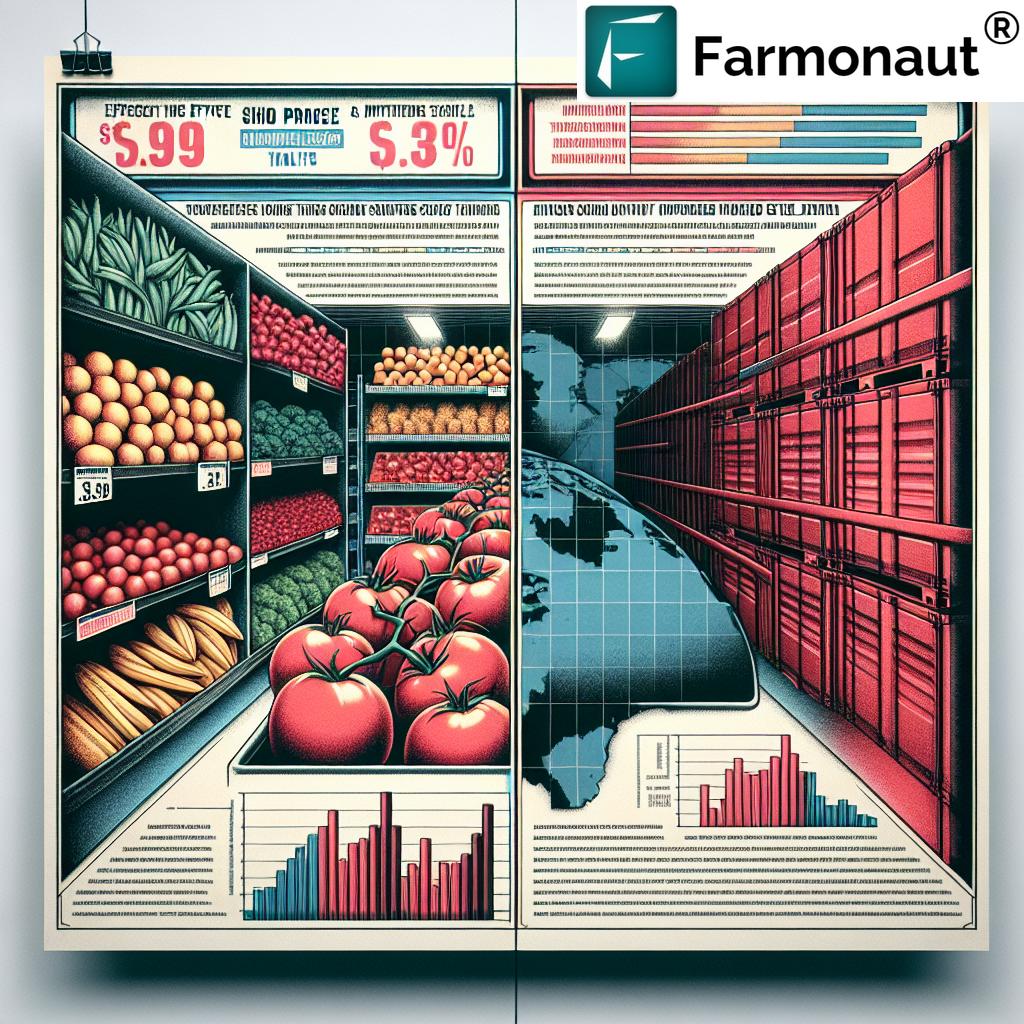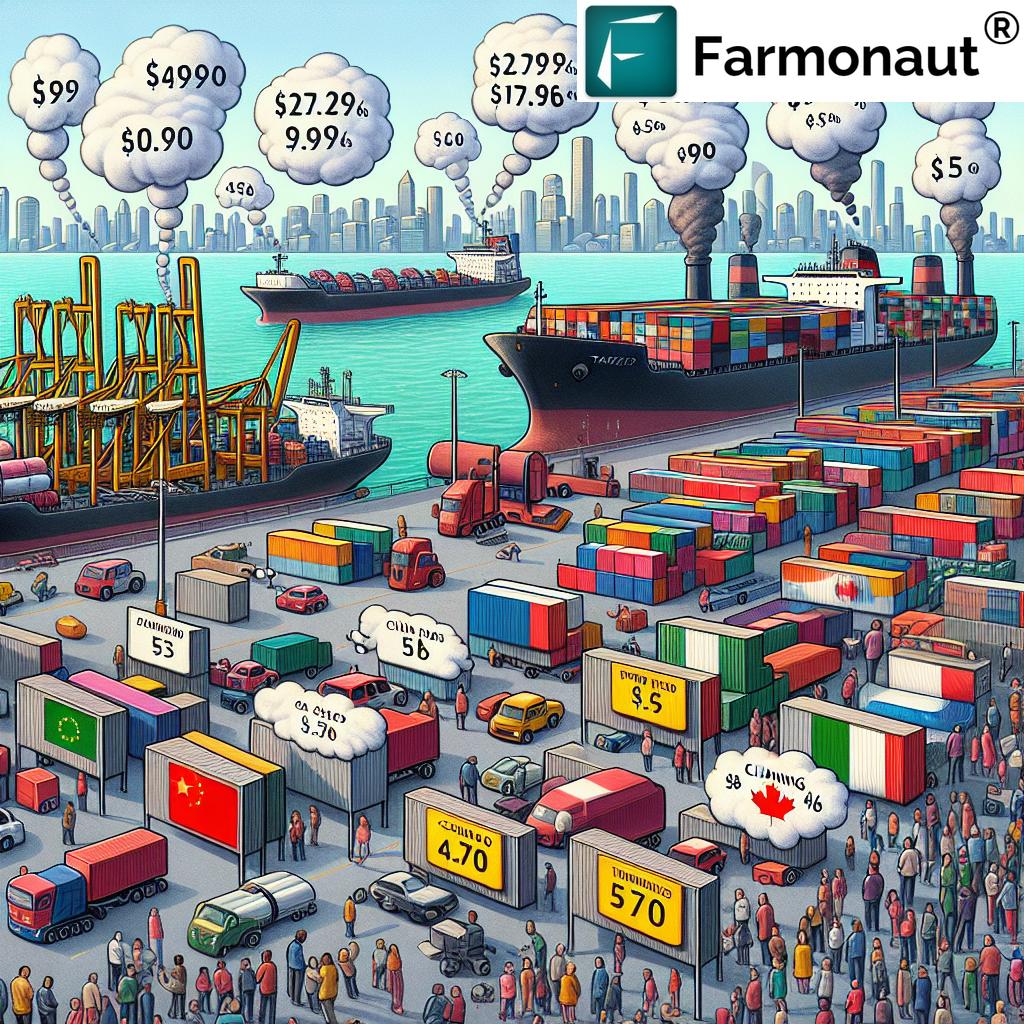Unveiling the Impact: How New US Tariffs on Imports Affect Consumer Prices and Agricultural Trade

“New US tariffs on imports from Canada, Mexico, and China affect goods across multiple sectors, impacting millions of consumers.”
In recent economic developments, the United States has implemented new tariffs on imports from Canada, Mexico, and China, sparking widespread discussions about their potential impact on consumer prices and agricultural trade. As we delve into this complex issue, we’ll explore how these trade policies are reshaping the economic landscape and what it means for businesses and consumers alike.
Understanding the New Tariffs
The newly announced tariffs by President Donald Trump have been declared as an economic emergency, extending beyond previous measures that primarily targeted China and specific steel imports from Canada and Europe. Let’s break down the key aspects of these tariffs:
- A 25% additional tax on goods imported from Mexico and Canada
- A 10% tariff on imported Canadian oil, natural gas, and electricity
- A 10% tariff on goods imported from China
These tariffs cover a wide range of products, including oil, agricultural goods, and vehicles. The breadth of affected industries underscores the significance of these measures and their potential to reshape trade relationships with at least three major US trading partners.
The Economic Ripple Effect
To understand the full impact of these tariffs, we need to consider how they affect various stakeholders in the economy. Dr. Daraius Irani, chief economist at Towson University, provides valuable insights into the implications for consumers and businesses.
Consumer Impact
At its core, a tariff functions as a tax on imported goods entering the United States. While the immediate cost is borne by importers, the ultimate burden often falls on consumers. The extent to which households feel the impact depends on several factors:
- The specific product being taxed
- Market conditions and elasticity of demand
- Availability of domestic alternatives
For instance, consumers may not immediately feel the full brunt of tariffs on goods like tomatoes, as domestic production can partially offset imports. However, producers may gradually raise prices in response to the tariffs, passing some costs onto consumers.
Impact on Domestic Manufacturing
One of the primary goals of these tariffs is to boost domestic manufacturing. However, the reality is more complex than simply imposing taxes on imports. Several challenges arise:
- Transitioning specific industries, like oil refining, back to the US is challenging due to established refinery systems designed for imported oil
- Uncertainty about the longevity of tariffs may deter companies from making long-term investments in US manufacturing facilities
- Even if manufacturing returns, it’s likely to be dominated by high-tech processes and automation, requiring fewer workers than traditional manufacturing jobs
This shift in manufacturing dynamics highlights the evolving nature of industry and employment in the face of technological advancements and changing trade policies.
Agricultural Sector: A Key Player in the Tariff Game
The agricultural sector stands at the forefront of these trade tensions. As a significant exporter and importer, US agriculture faces both opportunities and challenges under the new tariff regime.
Impact on Farmers and Producers
American farmers find themselves in a precarious position. While tariffs on imported agricultural products may offer some protection for domestic producers, they also face potential retaliation from trading partners. This could lead to:
- Reduced export opportunities for US agricultural products
- Increased input costs for farmers relying on imported machinery or fertilizers
- Volatility in commodity prices due to market uncertainty
In this changing landscape, farmers need to adapt quickly and efficiently. Tools like those offered by Farmonaut can provide valuable insights for agricultural management in uncertain times.

Consumer Prices and Food Security
The ripple effect of these tariffs extends to consumer food prices. While the impact may not be immediate, we can expect to see changes in the cost of various food items:
- Imported fruits and vegetables may become more expensive
- Processed foods using imported ingredients could see price increases
- Domestic producers may raise prices to capitalize on reduced foreign competition
These price fluctuations could have implications for food security, especially for lower-income households. It’s crucial for policymakers to consider these potential consequences when implementing trade policies.
Oil and Energy: A Complex Equation
The new tariffs on Canadian oil, natural gas, and electricity add another layer of complexity to the US energy market. Here’s how these measures could impact the sector:
Refinery Challenges
As mentioned earlier, transitioning oil refining back to the US poses significant challenges:
- Many US refineries are optimized for processing imported oil
- Retrofitting or building new refineries for domestic oil is a costly and time-consuming process
- The uncertainty surrounding the longevity of tariffs may deter such investments
These factors could lead to increased fuel prices for consumers, at least in the short to medium term.
Energy Independence vs. Market Efficiency
While the tariffs aim to promote energy independence, they may also lead to market inefficiencies:
- Higher energy costs could impact various industries, potentially reducing their competitiveness
- Consumers may face higher utility bills, especially in regions relying on imported electricity
- The shift in energy sources could have environmental implications, depending on the types of energy promoted
Balancing the goal of energy independence with market efficiency and environmental concerns will be a key challenge for policymakers.
International Trade Relations: A Delicate Balance
The implementation of these tariffs has not gone unnoticed by US trading partners. The response from Canada and Mexico has been swift, highlighting the potential for escalating trade tensions.
Retaliatory Measures
Both Canada and Mexico have announced plans for reciprocal tariffs:
- Canada’s Prime Minister Justin Trudeau announced an equivalent 25% tariff on up to $155 billion in US imports, including products like fruit and alcohol
- Mexico has indicated plans for similar retaliatory tariffs
These counter-measures could have significant implications for US exporters, particularly in industries like American bourbon production.
Long-term Trade Relationships
The current trade tensions raise questions about the future of international trade relationships:
- Will these tariffs lead to renegotiation of existing trade agreements?
- How will they affect regional economic partnerships like NAFTA?
- Could they result in a reshaping of global supply chains?
As these questions linger, businesses must adapt to a changing international trade landscape. Tools for managing global operations, such as those offered by Farmonaut’s API, can be invaluable in navigating these uncertainties.
“The implementation of new import taxes could potentially reshape trade relationships with at least 3 major US trading partners.”
The Manufacturing Sector: Opportunities and Challenges
One of the primary goals of these tariffs is to revitalize US manufacturing. However, the path to achieving this goal is far from straightforward.
Potential for Domestic Growth
The tariffs could create opportunities for domestic manufacturers:
- Increased competitiveness against imported goods
- Potential for new investments in US-based production facilities
- Job creation in manufacturing sectors
However, these opportunities come with significant challenges and uncertainties.
Automation and Workforce Dynamics
Even if manufacturing does return to the US, it’s likely to look very different from traditional manufacturing jobs:
- High-tech processes and automation are likely to dominate new manufacturing facilities
- The workforce will need different skills, focusing more on technical and operational roles
- The number of jobs created may be less than expected due to automation
This shift underscores the need for workforce development and education initiatives to prepare workers for the manufacturing jobs of the future.
Consumer Behavior and Market Adaptation
As the effects of these tariffs ripple through the economy, we can expect to see changes in consumer behavior and market dynamics.
Shifting Consumer Preferences
Higher prices on imported goods may lead to changes in consumer buying habits:
- Increased demand for domestically produced alternatives
- Potential shift towards more affordable options or substitutes
- Greater price sensitivity in certain product categories
Businesses will need to be agile in responding to these changing consumer preferences.
Market Adaptations
Industries affected by the tariffs will likely adapt in various ways:
- Diversification of supply chains to mitigate risk
- Increased focus on efficiency and cost-cutting measures
- Exploration of new markets to offset potential losses
These adaptations could lead to innovations in production and distribution methods, potentially benefiting consumers in the long run.
The Role of Technology in Navigating Trade Challenges
In the face of these complex trade dynamics, technology plays a crucial role in helping businesses adapt and thrive. Tools like those offered by Farmonaut can provide valuable insights and efficiencies:
- Satellite-based crop monitoring for optimized agricultural production
- AI-driven advisory systems for informed decision-making
- Blockchain-based traceability for enhanced supply chain management
These technological solutions can help businesses navigate the uncertainties of changing trade policies and market conditions.
Explore how Farmonaut’s solutions can benefit your agricultural operations:
Looking Ahead: The Future of US Trade and Economy
As we navigate these complex trade dynamics, several key factors will shape the future of US trade and the broader economy:
Ongoing Negotiations
The current tariffs are likely to be a starting point for further negotiations:
- Potential for revised trade agreements with Canada, Mexico, and China
- Ongoing discussions about fair trade practices and intellectual property rights
- Possible adjustments to tariff rates based on economic impacts and political considerations
Global Economic Trends
The impact of these tariffs will play out against a backdrop of broader global economic trends:
- Shifts in global supply chains and production centers
- Technological advancements reshaping industries and labor markets
- Growing emphasis on sustainability and environmental considerations in trade
Understanding these trends will be crucial for businesses and policymakers alike.
Comparative Analysis: Impact of New US Tariffs on Key Sectors
| Sector | Estimated Price Increase (%) | Potential Job Impact | Consumer Effect |
|---|---|---|---|
| Agriculture | 5-10% | Moderate decline in exports | Higher food prices |
| Automotive | 3-7% | Mixed; potential growth in domestic production | Increased vehicle prices |
| Oil & Gas | 2-5% | Potential growth in domestic production | Higher energy costs |
| Manufacturing | 4-8% | Possible increase in domestic jobs | Higher prices for consumer goods |
Conclusion: Navigating the New Trade Landscape
The implementation of new US tariffs on imports from Canada, Mexico, and China marks a significant shift in trade policy with far-reaching implications. As we’ve explored, these measures affect a wide range of sectors, from agriculture and manufacturing to energy and consumer goods.
While the tariffs aim to protect and stimulate US industries, they also introduce complexities that could impact consumers through higher prices and potential economic retaliation from trading partners. The long-term effects on domestic manufacturing, job creation, and international trade relationships remain uncertain and will likely evolve as discussions and negotiations progress.
For businesses navigating this changing landscape, staying informed and adaptable is key. Leveraging technology and data-driven insights, such as those provided by Farmonaut’s agricultural solutions, can help in making informed decisions and optimizing operations in the face of market uncertainties.
As we move forward, it will be crucial to monitor the ongoing impacts of these tariffs, the responses of international trading partners, and the adaptations made by various industries. The balance between protecting domestic industries and maintaining beneficial international trade relationships will continue to be a central challenge for policymakers and a key consideration for businesses operating in the global marketplace.
In this evolving economic environment, staying informed, leveraging technology, and remaining adaptable will be crucial for businesses and consumers alike as we navigate the complexities of international trade in the 21st century.
FAQ Section
Q1: How will the new US tariffs affect consumer prices?
A1: Consumer prices are likely to increase for goods affected by the tariffs, though the extent may vary depending on the specific product and market conditions. Imported goods will become more expensive, and domestic producers may also raise prices in response to reduced competition.
Q2: Will these tariffs create more jobs in the US?
A2: While the tariffs aim to boost domestic manufacturing and potentially create jobs, the reality is complex. Some sectors may see job growth, but many new manufacturing facilities are likely to be highly automated, requiring fewer workers than traditional factories.
Q3: How are other countries responding to these new US tariffs?
A3: Trading partners like Canada and Mexico have announced retaliatory tariffs on US goods. This could lead to escalating trade tensions and impact various US export industries.
Q4: What sectors are most affected by these tariffs?
A4: The tariffs affect a wide range of sectors, including agriculture, automotive, oil and gas, and manufacturing. Each sector faces unique challenges and potential opportunities as a result of these trade measures.
Q5: How long are these tariffs expected to remain in place?
A5: The duration of these tariffs is uncertain and may depend on ongoing negotiations and economic impacts. This uncertainty can affect long-term business planning and investment decisions.
Earn With Farmonaut: Affiliate Program
Earn 20% recurring commission with Farmonaut’s affiliate program by sharing your promo code and helping farmers save 10%. Onboard 10 Elite farmers monthly to earn a minimum of $148,000 annually—start now and grow your income!




















